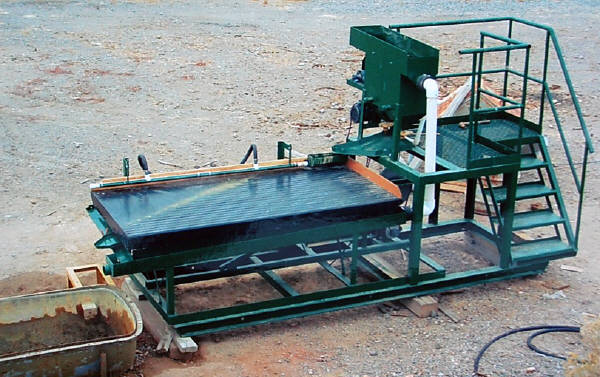|
Consider the economics of using a concentrating table. Also known as shaking tables or bump tables.
First off, here are some quotable quotes from Ian after he worked with two mineral processing operators in Australia.
I keep doing tests on people's tails and the M8 keeps scavenging lost fine heavy minerals!
The tantalite tests went really well. The manager helped put 100kg of his tails thru and he was stoked at how much very fine tantalite was recovered. I worked out that he is losing approx $1000 per hour (which the Table would catch).
The takeaway: Concentrating tables save money!

The Economic Advantages of Concentrating Tables in Mineral Extraction
Mineral extraction is a complex process that involves separating valuable minerals from ore. One crucial tool in this process is the concentrating table, also known as a shaking table or a gold shaker table. These tables play a vital role in mineral recovery by using gravity, water and vibration to separate minerals based on their specific gravity.
Concentrating tables are cost-effective solutions that can save mining companies money in the long run. By efficiently separating valuable minerals (gold in this case) from waste material, these gold shaking tables help increase overall yield and reduce the amount of material that needs further processing. This leads to significant cost savings in terms of energy, labor, and equipment maintenance.
One of the key advantages of concentrating tables is their ability to recover a wide range of minerals with varying densities. This versatility allows mining operations to extract multiple valuable minerals from a single ore source, maximizing profitability. Additionally, concentrating tables have a relatively low initial investment cost compared to other separation technologies, making them an attractive option for both large-scale mining operations and smaller artisanal mines.
To illustrate the economic benefits of concentrating tables, let's look at some real-life case studies. In one example, a gold mining company implemented concentrating tables into their operation and saw a 20% increase in overall gold recovery rates. This led to a significant boost in revenue without increasing production costs, ultimately resulting in higher profit margins for the company.
Another case study involves a copper mine that integrated concentrating tables into their processing plant. By efficiently separating copper sulfide minerals from gangue material, they were able to reduce processing costs by 15% while increasing copper concentrate grade by 10%. These improvements not only saved the company money but also enhanced their reputation within the industry.
To maximize profit margins with concentrating tables, mining operations should follow some key tips. First and foremost, it's essential to optimize table settings based on the specific characteristics of the ore being processed. Adjusting parameters such as stroke length, frequency, and water flow rate can significantly impact separation efficiency and overall recovery rates.
Additionally, regular maintenance and calibration of shaking tables are crucial for ensuring consistent performance over time. By monitoring table performance and making necessary adjustments proactively, mining companies can prevent downtime and costly repairs down the line.
Put simply, concentrating tables offer significant economic advantages for mineral extraction operations. By efficiently separating valuable minerals from waste material, these shaker tables help save money on processing costs while maximizing overall yield. Through real-life case studies and practical tips for implementation, it's clear that a concentrating table is an indispensable tool for turning ore into wealth in the mining industry. That's why Ian likes and uses the Gold Wave Table by Action Mining. Check it out. |
|

